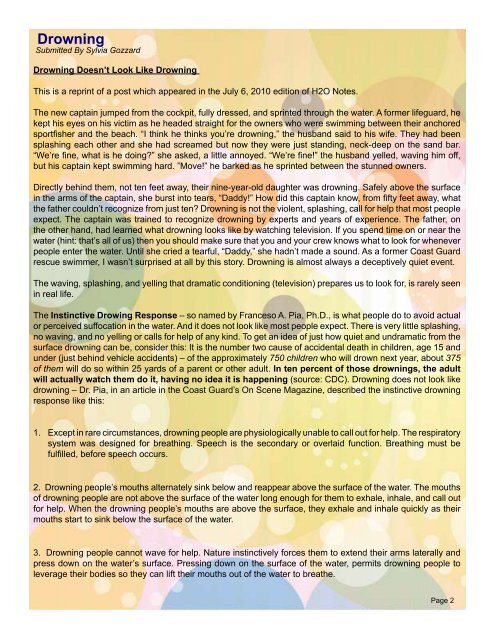You also want an ePaper? Increase the reach of your titles
YUMPU automatically turns print PDFs into web optimized ePapers that Google loves.
Drowning<br />
Submitted By Sylvia Gozzard<br />
Drowning Doesn’t Look Like Drowning<br />
This is a reprint of a post which appeared in the July 6, 2010 edition of H2O Notes.<br />
<strong>The</strong> new captain jumped from the cockpit, fully dressed, and sprinted through the water. A former lifeguard, he<br />
kept his eyes on his victim as he headed straight for the owners who were swimming between their anchored<br />
sportfisher and the beach. “I think he thinks you’re drowning,” the husband said to his wife. <strong>The</strong>y had been<br />
splashing each other and she had screamed but now they were just standing, neck-deep on the sand bar.<br />
“We’re fine, what is he doing?” she asked, a little annoyed. “We’re fine!” the husband yelled, waving him off,<br />
but his captain kept swimming hard. ”Move!” he barked as he sprinted between the stunned owners.<br />
Directly behind them, not ten feet away, their nine-year-old daughter was drowning. Safely above the surface<br />
in the arms of the captain, she burst into tears, “Daddy!” How did this captain know, from fifty feet away, what<br />
the father couldn’t recognize from just ten? Drowning is not the violent, splashing, call for help that most people<br />
expect. <strong>The</strong> captain was trained to recognize drowning by experts and years of experience. <strong>The</strong> father, on<br />
the other hand, had learned what drowning looks like by watching television. If you spend time on or near the<br />
water (hint: that’s all of us) then you should make sure that you and your crew knows what to look for whenever<br />
people enter the water. Until she cried a tearful, “Daddy,” she hadn’t made a sound. As a former Coast Guard<br />
rescue swimmer, I wasn’t surprised at all by this story. Drowning is almost always a deceptively quiet event.<br />
<strong>The</strong> waving, splashing, and yelling that dramatic conditioning (television) prepares us to look for, is rarely seen<br />
in real life.<br />
<strong>The</strong> Instinctive Drowing Response – so named by Franceso A. Pia, Ph.D., is what people do to avoid actual<br />
or perceived suffocation in the water. And it does not look like most people expect. <strong>The</strong>re is very little splashing,<br />
no waving, and no yelling or calls for help of any kind. To get an idea of just how quiet and undramatic from the<br />
surface drowning can be, consider this: It is the number two cause of accidental death in children, age 15 and<br />
under (just behind vehicle accidents) – of the approximately 750 children who will drown next year, about 375<br />
of them will do so within 25 yards of a parent or other adult. In ten percent of those drownings, the adult<br />
will actually watch them do it, having no idea it is happening (source: CDC). Drowning does not look like<br />
drowning – Dr. Pia, in an article in the Coast Guard’s On Scene Magazine, described the instinctive drowning<br />
response like this:<br />
1.<br />
Except in rare circumstances, drowning people are physiologically unable to call out for help. <strong>The</strong> respiratory<br />
system was designed for breathing. Speech is the secondary or overlaid function. Breathing must be<br />
fulfilled, before speech occurs.<br />
2. Drowning people’s mouths alternately sink below and reappear above the surface of the water. <strong>The</strong> mouths<br />
of drowning people are not above the surface of the water long enough for them to exhale, inhale, and call out<br />
for help. When the drowning people’s mouths are above the surface, they exhale and inhale quickly as their<br />
mouths start to sink below the surface of the water.<br />
3. Drowning people cannot wave for help. Nature instinctively forces them to extend their arms laterally and<br />
press down on the water’s surface. Pressing down on the surface of the water, permits drowning people to<br />
leverage their bodies so they can lift their mouths out of the water to breathe.<br />
Page 2


